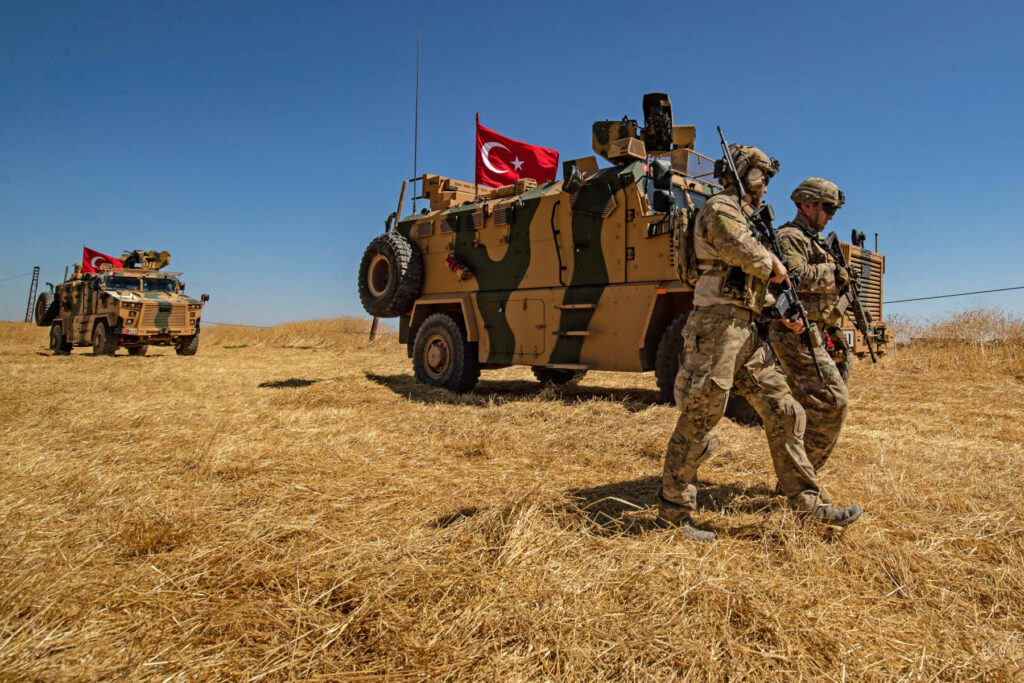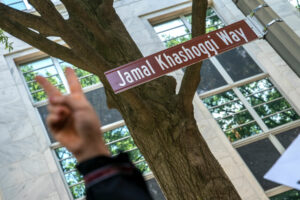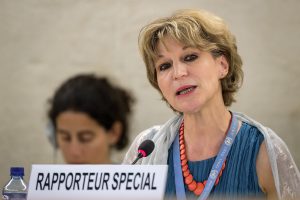Armenak Tokmajyan is an El Erian fellow at the Malcolm H. Kerr Carnegie Middle East Center in Beirut. His research focuses on borders and conflict, Syrian refugees, and state-society relations in Syria.
Syria's civil war has fundamentally altered the country's northern border with Turkey, creating a landscape of cantons that remain outside the control of President Bashar al-Assad's regime. Five variously self-governing entities emerged starting in 2016, which marked a fundamental turning point in the timeline of Syria's conflict. It changed from a country-wide war between many foreign-backed Syrian rebel groups and a regime in Damascus supported by Iran and Russia, into a conflict concentrated on the Syrian-Turkish border. Cantonization was the outcome of Turkish military intervention, the U.S.-backed campaign against ISIS, largely fought on the ground through local Kurdish forces, and the Assad regime's retaking of Aleppo with Russian backing.
The five cantons stretching across northern Syria have transformed a large swath of the country and created new political realities on the ground. But they could not survive without foreign support or protection, primarily from Turkey in the case of four of them. Three of these cantons were established through Turkish military incursions, starting with Operation Euphrates Shield in 2016, which took control of territory between the Euphrates River and the city of Azaz, north of Aleppo. That was followed by the Turkish military's 2018 takeover of the nearby city of Afrin, and Operation Peace Spring in 2019, when Turkish forces occupied territory between the towns of Tel Abyad and Ras al-Ain. The fourth canton in northwest Syria is rebel-held Idlib, governed by the Islamist group Hayat Tahrir al-Sham, and where Turkey has also extended a protective umbrella. The fifth canton, in northeast Syria, is under Kurdish control with support from the United States.
Syria's civil war has fundamentally altered the country's northern border with Turkey, creating a landscape of cantons that remain outside the control of President Bashar al-Assad's regime.
- Armenak Tokmajyan
Through their continued existence, these territories stand at odds with the Assad regime's vision of Syria and its sovereignty, and are in constant need of cross-border aid and commerce to survive. Although it is unlikely that these cantons will disappear anytime soon, they will also not remain entirely as they are. Instead, we are likely to see adjustments to the space they dominate—adjustments of the boundaries of these cantons, of their economic linkages with the Assad regime, with each other and the outside world, and with the way humanitarian aid enters these areas. Such adjustments would most likely be the result of bartering, bargaining or negotiations, particularly between the regime, Turkey and Russia, reflecting the fractured state of Syria and where power lies in the north of the country. These bargains would come at the expense of these cantons without fully eliminating them.
Two essential and interlinked threads of events that reshaped Syria's northern borderlands explain how these cantons emerged and how their fates will be determined. First, Russia's military intervention in Syria opened the gates for Moscow, Ankara and Damascus to redraw the map of northwest Syria, in parallel with the emergence of a U.S.-backed, Kurdish-dominated administration in northeast Syria fighting ISIS. Soon after Russia's intervention, Turkey withdrew its support for Syrian rebels in control of eastern Aleppo. This enabled the Assad regime to eventually recapture the city by late 2016, with the help of devastating Russian airstrikes. Simultaneously, Turkey launched Operation Euphrates Shield, with Russia's tacit consent. The cross-border Turkish incursion was aimed at fighting ISIS as well as preventing Kurdish forces from taking control of enough territory to connect the border cities of Manbij and Afrin, both of which were under Kurdish control at the time. Turkey feared such a large Kurdish area just over its border, occupying a belt of vital territory north of Aleppo.

A new political map of northern Syria began to appear. Aleppo's recapture by the Assad regime marked the beginning of a series of regime offensives across the country with Russia's help that, ultimately, confined Assad's opponents to the northwest corner of the country, primarily Idlib. It also set a precedent for bartering and bargaining between the regime, Russia, Iran and Turkey, resulting in the redrawn map of the northwest several times over. In tandem, in the context of the war against ISIS, in 2016, the Kurdish-dominated Syrian Democratic Forces and its civilian wing, with the cooperation of the U.S., came to control a large chunk of territory in northeast Syria independently of—and despite the opposition of—Turkey, Russia and the Assad regime. In retrospect, 2016 was the year when Syria's borderlands with Turkey started becoming cantonized.
But this new cantonized landscape along the border was not only the outcome of these major interventions. In many instances, the evolution of the war, along with demographic and humanitarian realities on the ground, imposed their own will. The second essential thread of events is linked exactly to that—particularly, how the northwest became the epicenter of Syria's crisis of internal displacement, where more than half of the region's 4.6 million people are internally displaced with nowhere to go. The roads to Turkey are not open, and nor is there a genuine plan by the Assad regime to reintegrate these millions of IDPs into wider Syrian society. Thus, the northwest has become the last haven for a large segment of Syria's population that does not want to, or cannot, coexist with the regime in Damascus. The northeast, with its PKK-dominated Kurdish rule and sizable Kurdish population that has been living outside Assad's control for a decade now, is also at odds with his regime.
Although Damascus has little ability, and perhaps little willingness, to reabsorb the whole of northern Syria back under its rule, it could work toward adjusting these cantons to its favor with the help of its allies—or even through rapprochement with its once-nemesis, Turkey. The Assad regime may even be able to reap the benefits of its long struggle to become the master of Syria once again—not by retaking all territory in its entirety, but by potentially manipulating northern Syria's cantonization to its advantage and thereby securing small gains.
For the inhabitants of these cantons, they are consigned to a life in between—in entities that are not fully part of either Syria or Turkey, yet also not independent.
- Armenak Tokmajyan
Diplomatic normalization between Turkey and Syria is still a long way off, but their interests align enough to enable certain trade-offs when it comes to the cantons lining their shared border. This is particularly true of the four northwestern cantons, especially Idlib, Afrin and the territory occupied under Operation Euphrates Shield. Ongoing rapprochement between Ankara and Damascus will likely continue in some shape or form, given that the Assad regime's recapture of these territories by force is unrealistic. There are many calculations on both sides when it comes to negotiations. At the end of the day, two stubborn governments that outlasted the Syrian war are bartering over a host of complicated issues shaped by the war, including demographic, security and economic interests along their shared border. These talks, if translated into an agreement, could yield a series of security and economic understandings over parts of one or more of the four northwestern cantons.
Any number of scenarios that may emerge from a normalization deal between Turkey and Syria, to whatever degree they involve adjustments of the boundaries of these cantons, could once again redraw the political map of Syria's northwest. Yet no scenario would do away with cantonization itself and return all these territories to the Assad regime as they existed before the war. If anything, rapprochement between Turkey and Syria could consecrate cantonization through some form of semi-formal acknowledgment. As such, although Idlib and the three Turkish-dominated cantons constitute a thorn in the Syrian regime's side and a burden for Turkey—especially after February's devastating earthquake—and despite the fact that they require a constant supply of aid through the border, these cantons will continue to exist in one form or another until a national framework reunites them, as well as the Kurdish-run northeastern canton, with the rest of Syria.
Considering how unlikely that scenario is, the borderlands of northern Syria will remain fragmented and out of the Assad regime's control, even if the war itself has ended. The reality in Syria after more than a decade of conflict is that the Assad regime still cannot retake all of this territory. For the inhabitants of these cantons, they are consigned to a life in between—in entities that are not fully part of either Syria or Turkey, yet also not independent.
The article is adapted from "A Fractured Border: Syria, Türkiye, and Cantonization," recently published by Armenak Tokmajyan and Kheder Khadour for the Carnegie Middle East Center.





































